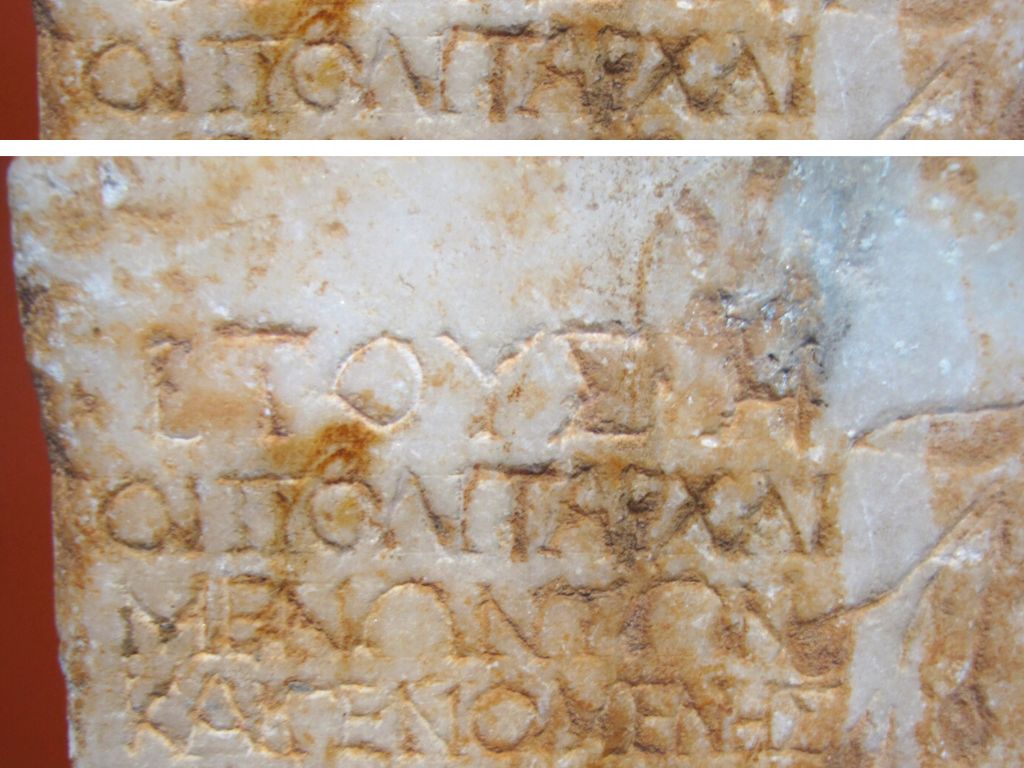In the Archeological Museum of Thessaloniki, we can find a 1 A.D. Greek inscription, ΟΙ ΠΟΛΙΤΑΡΧΑΙ, important for Christian apologetics. ΟΙ ΠΟΛΙΤΑΡΧΑΙ means “The City Authorities.” Prior to 1887 this very specific term for The City Authorities had never been found inscribed anywhere. This caused doubt.

The Rationalists of the 19th century said, “We have an issue against the authenticity of the New Testament, a big issue, because Thessaloniki was a capital city at the time of the Apostle Paul. If The City Authorities of Thessaloniki were called politarches (πολιτάρχης) then we should see this in other sources as well, but we don’t. This very specific term, πολιτάρχης is not mentioned in any inscriptions. So, the rationalists reasoned that, this term, politarches πολιτάρχης, was made up by Christians much later than 1 AD. However, the story doesn’t end there.
Here’s what happened:
In 1885, Ottoman authorities decided to demolish the walls, as well as the Royal Gate of Thessaloniki, in order to expand the road and the city. While demolishing the Royal Gate, the workers arrived at the foundations and there they found a stone with some letters on it. And because they were not able to read Greek, they called the British counsellor of the city. He knew all about this issue of the politarches (πολιτάρχης) and he was a Greek scholar and a Christian. This man saw the stone. He was thrilled! For the first time, he found this term, πολιτάρχης, used outside of the Bible.
The Ottoman workers were semi-drunk and the counsellor asked them, “How much would you like to sell this stone for?” As the story says, they looked to each other and asked the counsellor, “Five kilos wine? Is that too expensive for you?” For five kilos of wine, this stone became a property of the British Museum and the inscription disproved the Rationalists of the 19th century.
In the city of Thessaloniki alone, 30 more inscriptions have been found with this specific, technical term, πολιτάρχης, meaning “City Authorities.” And not only that, in all of Macedonia from Berea to Philippi, we have found even more inscriptions in Asia Minor, Middle East and even Egypt. These inscriptions, found from Thessaloniki to Egypt, cover a time distance between fourth century BC to fourth century AD. Without a doubt, these inscriptions verify the book of Acts, and its author, Luke.
Costas points at these Greek letters, ΟΙ ΠΟΛΙΤΑΡΧΑΙ. New Testament author, Luke, used the very same term, politarches (πολιτάρχης) in the book of Acts.

Acts 17:5-9 But the Jews became jealous, and they brought together some scoundrels from the marketplace, formed a mob, and started a riot in the city. Attacking Jason’s house, they searched for them to bring them out to the public assembly. 6 When they did not find them, they dragged Jason and some of the brothers before the πολιτάρχης (The City Authorities) shouting, “These men who have turned the world upside down have come here too, 7 and Jason has received them as guests! They are all acting contrary to Caesar’s decrees, saying that there is another king—Jesus!” 8 The Jews stirred up the crowd and the πολιτάρχης (The City Authorities) who heard these things. 9 So taking a security bond from Jason and the others, they released them.
The word πολιτάρχης (noun, accusative, plural, masculine) is mentioned two times in Acts, chapter 17, verse six. and verse eight, and this very same specific, technical term was inscribed on the stone of 1 AD.

Now, look here, you know how to read Greek. ΟΙ ΠΟΛΙΤΑΡΧΑΙ. Οι is the plural masculine article, “The” and πολιταρχαι is “City Authorities.” For those of you who know Greek grammar, you will recognize that ΠΟΛΙΤΑΡΧΑΙ and πολιτάρχης are exactly the same word, in the same number, both first plurals, both dating 1 AD.
The importance of the inscription on the stone is its dating of 1 AD. Paul was not in Thessalonik before 1 AD and he was not there after 1 AD. But he was there in 1 AD, and the City Authorities were too.

1 AD Inscription of ΟΙ ΠΟΛΙΤΑΡΧΑΙ
Costas Tsevas showed us other stones at the Archeological Museum of Thessalonkik. This one, an offering pedestal, also includes the inscription of City Authorities on the last line.

